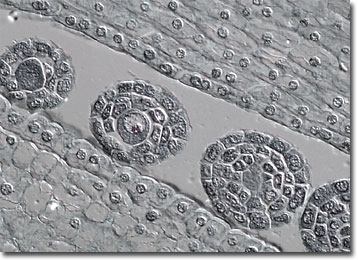Differential Interference Contrast Image Gallery
Lily Flower Buds
Though the family Liliaceae contains more than 250 genera and 4000 species, the term “lily” is usually only applied to around 100 species belonging to the genus Lilium. Among the oldest cultivated plants, the ancient Greeks and Romans utilized lilies as garden ornamentals and for medicinal purposes.

Herbaceous flowering monocots, lilies are usually raised from bulbs and grow best in loamy soil. Although the belief in their medicinal value seems to have been unfounded, the plants were used for many years to treat fever, rheumatism, and arthritis, as well as to clean wounds, burns, and sores. Such medical applications of lilies were especially popular in England during the Elizabethan period.
Lilies have held symbolic significance in a variety of cultures for thousands of years. Some of the earliest representations of the plants were discovered in a small villa in Crete and date from the Minoan period, or about 1580 BC. The Minoans considered lilies sacred and associated them with their great goddess Britomartis, who would serve as a precursor to the Greek goddess Artemis. Often emblematic of innocence and purity, ancient Greek and Roman brides wore crowns of lilies and, even today, many modern brides carry them in their bouquets. The plants sometimes alternatively symbolize fertility or rebirth, as in the popular Easter lily, and have been believed by some to hold mystical power against evil spirits and ghosts.
